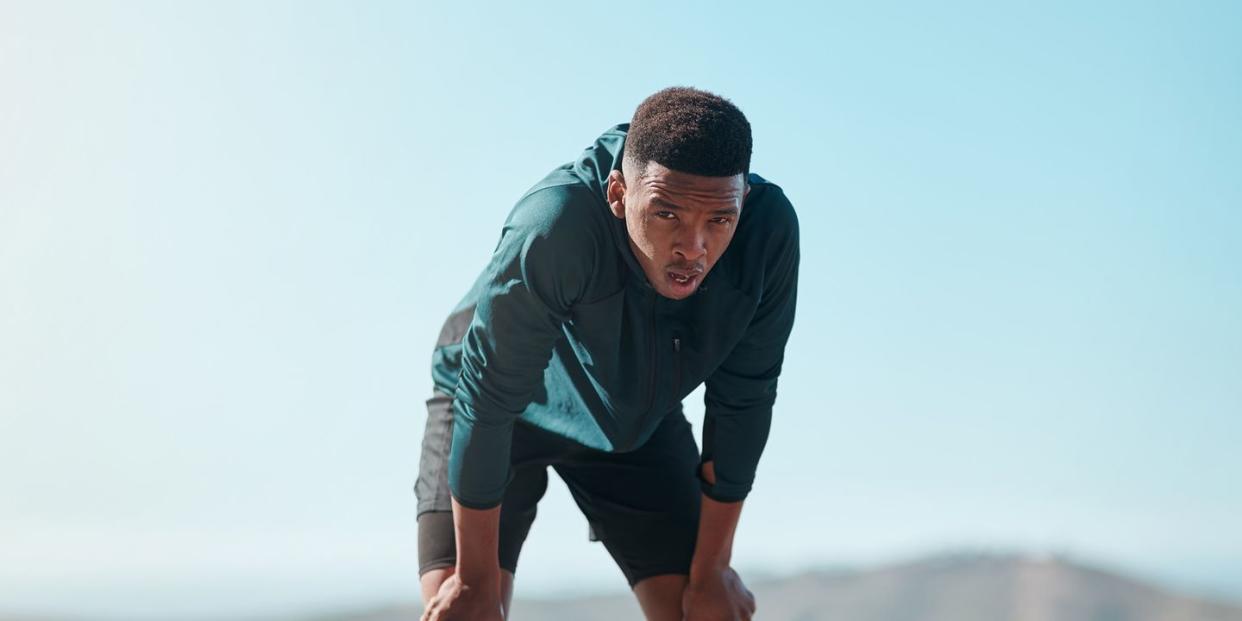Should you bend over and put your hands on your knees between interval reps?

When I started running in high school, my coach forced me to put my hands on my head and stand tall when recovering from track intervals. My default had been to bend over and put my hands on my knees. I remember doing it and instantly feeling worse than when I was bent over. Almost 30 years later, my experience has been backed up by research. Researchers from Western Washington University got 20 women footballers to do hard four-minute running repeats on a treadmill, recovering for three minutes either with their hands on their knees or their heads. They then measured heart and breathing rates to compare.
Knees up
The results suggest the hands-on-knees position outperforms the hands-on-head method in many key variables for better recovery. I say ‘suggest’, because the study didn’t measure performance directly; it used physiological measurements to infer whether athletes had recovered better.
For instance, they measured heart-rate recovery – the degree to which heart rate decreases in the first minute after each bout of running – and found that with hands on knees, it dropped by 53 beats, compared with 31 when standing up with hands on head. They also measured tidal volume– the amount of air inhaled with each breath – and that, too, was better with hands on knees, by about 10%. Not a slam dunk, but these differences suggest the athletes would be better recovered for subsequent exercise after hands-on-knees recovery. If they’d measured performance in a few trials after this demanding training bout, the theory might have been confirmed.
Regardless, there’s also theory behind these findings. Getting your head to the level of your heart may help with blood-pressure regulation, because your heart no longer has to pump against gravity. Secondly, when you’re bent over, your main breathing muscle, the diaphragm, is in a more effective position than when you’re standing – particularly if you also put your hands on your head, which stretches your thorax and abdominal muscles, making them less useful for contributing to breathing. The hands-on-knees approach causes your ribcage to rotate internally and optimises how well your diaphragm works.
Auto-regulation
There’s also perception. Have you ever stood up too fast, felt light-headed and known the best thing to do is sit down or bend over and gather yourself? That’s your body dealing with a blood-pressure challenge. The point is, your body is good at regulating its own physiology. That’s why our default action when tired and gasping for air is often to bend over. And if it feels better, in terms of exercise, it usually is.
Try it for yourself
Test both postures using the heart-rate recovery method described in the study...
Day 1
Perform a hard running session that you do frequently. This might be a track interval session, a hard 5K loop or some hill repeats – anything that gets your heart rate up to near its maximum level. As soon as you finish, note your heart rate. Then stand with your legs shoulder-width apart, bend at the waist and rest your hands on your knees, elbows bent, for one minute. Then note your heart rate again and record the difference between it at the end of the run and the one-minute recovery. If you’re doing an interval session, do this after each rep for a more reliable outcome.
Day 2
Repeat everything as closely as possible – do an identical session, run the same pace or times for the repeats. But this time, recover in the hands-on-head position: stand upright with your legs shoulder-width apart, tall and straight, and clasp your hands behind your head for one minute.
Compare your heart-rate recovery figures for the two days. The higher one indicates your preferred recovery posture.
You Might Also Like


